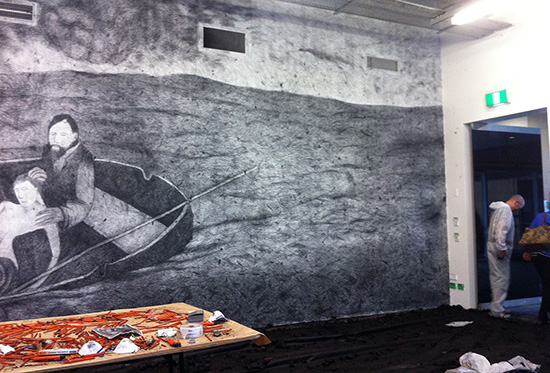I was recently fortunate enough to be one of the voluntary team members helping to create Richard Lewer’s monumentally-sized drawing, ‘The Custom of the Sea’. This work is exhibited at AUT’s St Paul St Gallery from 17 April – 22 May 2015. It was a mammoth task, taking place over several days with teams of drawing assistants taking shifts of several hours at a time. The drawing evolved slowly, emerging from seemingly random abstract lines and shadings in charcoal, and from moments where we literally threw clumps of raw charcoal at the gallery walls with all our might. A truly rewarding experience, and a testament to the power of collaboration.
Taken from St Paul St Gallery press release: “Faced with a life or death choice, what would you do? Until we find ourselves in such a situation we can’t be sure what lengths we’d go to in order to stay alive.
There are many stories of survival in human history and many of them come from situations at sea. Richard Lewer’s The Custom of the Sea is a response to one such story from 1884. It is the true story of four men cast adrift after their yacht the Mignonette was shipwrecked about 1,600 miles from the Cape of Good Hope on the journey from England to Australia. After more than two weeks without food and fresh water, two of the men, Tom Dudley and Edwin Stephens, made the decision to kill and eat the unconscious fourth crew member Richard Parker so that the remaining three might survive. The third crewmember, Edmund Brooks, objected.
The title of the work comes from a custom said to be in operation at sea. In a shipwreck it is deemed acceptable for those shipwrecked to draw lots to see who will be killed and eaten so that the others may survive. It is hard to imagine that this situation was common enough at the time to become an accepted practice with its own rules. In fact the shipwrecked men from the Mingonette didn’t even follow this custom of drawing straws, but as Parker was already ill they made the decision to go ahead and kill and eat him.
Lewer is interested in situations of intense personal struggle and the moral choices involved in what people will do to survive. In working with true stories of struggle and crime Lewer positions himself as a social realist artist. His work The Custom of the Sea for ST PAUL St is a large-scale wall drawing rendered with help from a group of volunteers. Lewer works with volunteers to achieve the scale within a limited time, but he is also interested in the social aspect of working with others to realise these large-scale projects. The activity of working together over several days is also a bonding exercise, and the chance to share technical skills. The final work presents a dark subject in a beautifully rendered soft and dense charcoal that creates a powerful experience for viewers.”


